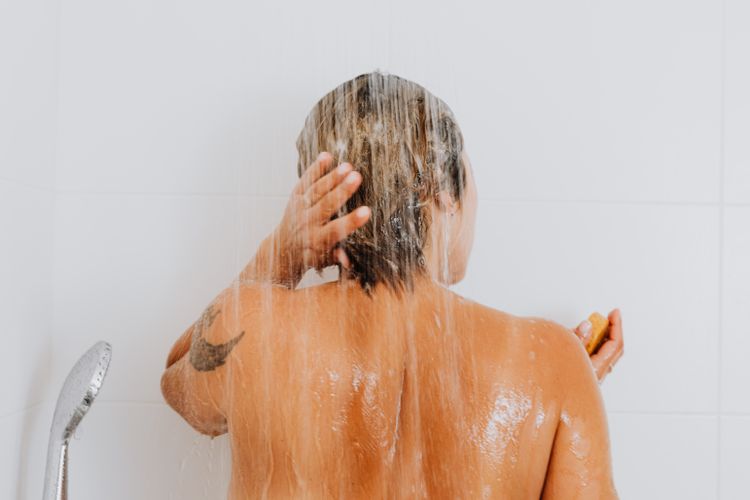When I was 18, I spent a summer living and studying in Northern India. Part of that stay involved several week homestay with a Tibetan family, taking a 10-day trek in the Himalayas through 16,000 ft passes and spending a few weeks in the moonscape of Ladakh, Kashmir. Needless to say, hot water was a luxury, if available at all. If I wanted to bathe, it was by bucket or river, and the water was COLD! It was intense and challenging, but the vivifying effect undeniable,
Inspired by the disciplined daily schedule of the Tibetan monks I met, I endeavored to maintain this practice of cold showers upon returning home. My first job back then was working in a coffee shop in the wee morning hours. I would get up at 4:30 practice meditation and take a freezing cold shower before getting to work at 5:30. It was awful! I can't believe I did that sh*t; I must have been crazy!
Anyways, fast forward a decade or two, and I am back at it. In fact, it has become one of the pillars of my own wellness routine, and something I prescribe to patients for a variety of conditions from chronic inflammation, to high blood pressure, to depression (if really you want to get in touch with your will to live, get into an ice-cold river!) While it is rarely easy or pleasant, it isn't impossible, and when I step out of that freezing shower, I feel like superman! The positive health effects benefit our metabolism, vascular, endocrine, and nervous systems, even mood and psychology. That intensity has an immediate calibrating effect on the nervous system: if you can get into an ice-cold shower first thing in the morning, the rest of your day becomes a lot more manageable!
In the Netherlands in 2015, a randomized control trial1 was conducted involving 3,000 participants over a 3-month period. They were instructed to take a warm shower as usual, but to end with 30-90 seconds of the coldest available water temperature (which averaged about 50 F). Nearly 80% of the intervention group completed the protocol and they reported a 29% reduction in sickness absence (missed days of work due to illness) compared to the control group. The duration of the cold shower did not seem to influence the outcome and interestingly, there was no reduction in the total number of days ill, only days absent from work. What this suggests is that systematic cold exposure may modulate the intensity (but not the duration) of illness. It may not prevent you from getting sick, but it may significantly alleviate your symptoms!
In the same study, they found that regular physical activity also resulted in 35% reduction of sick days. When combined with cold exposure this number jumped to 54% reduction compared to those who did neither! Other noted benefits include improved quality-of-life and perceived energy levels.
Think about that! With just 2 things: regular exercise and 30 seconds of cold water exposure, you can reduce the severity of an illness by over 50%!
I experienced this recently when my wife and toddler both got the flu simultaneously. They were quite ill for about 10 days with fever, lots of fluids, and coughing. I tended to the family in close quarters, but I never got sick! Whenever I would feel the symptoms coming on, I would do 20 minutes of Wim Hof breathing, and take a cold shower for about 5 minutes, or until I got brain freeze! Afterward, I felt fine. I had to do 2 sessions a day to keep from being overtaken by the flu.
The health benefits of cold exposure have become more popular in the last several years. The "Ice Man" Wim Hof has shown his ability to retain a constant core temperature through his method of cold exposure, breathing techniques, and concentration, even when submerged in a tank of ice for 2 hours. The feat which is rewriting textbooks, however, is his ability to consciously attenuate his own immune response. Researchers at the Radboud Medical Center in the Netherlands found Hof (and a group he trained in 4 days) were able to significantly increase their leukocyte count and decrease inflammatory cytokines TNF-α, IL-6, and IL-82. They were able to voluntarily influence their autonomic nervous system and innate immune response; something humans are not supposed to be able to do!
Cryotherapy is another option available in which gasified nitrogen (160-236 F below 0) is used for 2-3 minutes at a time to initiate the body's -cold-shock response. While the research argues there is still insufficient evidence to determine effectiveness3, Cryotherapy spas are quickly popping up in trendy neighborhoods. But at $50 a session, a freezing shower seems more viable.
The cold-water cure is nothing new. From Victorian Sanitariums to Roman baths, to Hippocrates, the father of medicine, the salutary effect of cold-water exposure has to be felt to be believed.
It's something I practice myself and recommend to many patients. As Wim Hof says, "A cold shower a day keeps the doctor away!"
REFERENCES


